Honey farming is the process of collecting honey bottles and honeycombs from beehives and bee nests. To get honeycombs, you can use shears when the beehive or bee nest has reached honey_level 5. Honeycomb is used for crafting your own beehives or bee nests for bees to inhabit, as well as for crafting decorative honeycomb blocks. To get honey bottles, you can use an empty bottle on a hive or nest at honey level 5. Honey bottles are food items that are able to cure poison, and can also be used for crafting sugar and honey blocks, the latter of which have sticky properties that give them a variety of useful applications.
Honey is generated by bees after they collect pollen and nectar. Bees emerge from their home and go looking for flowers. After collecting pollen and nectar at the flowers, the bees return home and go inside to turn the nectar into honey. When done, the bees emerge again to look for more flowers. Over time the honey collects until the bee nest or beehive is full and can then be harvested by the player in various forms.
Getting Started
Obtaining Bees
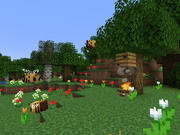
Bee nests can be found naturally generated in some biomes such as the flower forest. As shown here, it is important to place a campfire beneath before harvesting from it to avoid angering the bees nearby. For if you do anger the bees, they will attack you, lose their stingers in the process and die shortly after.
The first step on your foray into apiculture is to find bees in your world. Your initial source of bees will be a naturally generated or spawned bee nest. Bee nests have a small chance to generate on oak or birch trees in specific biomes during world generation. After world generation, there is also a chance for a bee nest to spawn on a tree when that tree grows near flowers (see post-generation).
Bee nests and beehives both slowly fill up with honey over time as the bees do their work collecting pollen from flowers. If you find a natural bee nest and it is conveniently located, you can leave it as is and return to collect the honey when you want.
If you want the bees at another location, you have a few options for getting them there. First, you will need a beehive at the new location. (Beehives are constructed using honeycomb. To get your first honeycomb, you will need to find a bee nest that has reached honey level 5 and then use shears on it. See Avoiding Bee Anger below.) You can then bring bees to your hive from the nest. You can also just move a whole nest if you want, see below.
Bees can be lured using any type of flower (including 2-block flowers and wither roses), and can also be moved using leads. (The bees follow the flowers because they want to eat them. If you feed the bees the flowers, they will enter love mode and breed, producing a baby bee.) However, if the bee nest is situated at a large distance from where you wish to do your beekeeping, a convenient way to transport bees is to break an occupied bee nest with a tool with Silk Touch and bring the nest with you. Bees that are occupying the nest when it is broken with a tool with Silk Touch will remain inside the nest as an item and will not get angry with you. Bees will attempt to return to their nests at night or when it is raining, making them both optimal times to break the nest. Keep in mind that breaking a bee nest without a tool with silk touch will break it without dropping anything, and all the bees that were both outside and inside the nest will swarm the player regardless of whether or not a campfire was placed underneath it.
If you don't have a tool with Silk Touch or don't want to remove the bee nest from its natural location, another option is to stay with the bees as they work until they have filled their nest with honey. Then, place a campfire at least two blocks directly below the hive, and put carpet on top of the campfire. The campfire keeps the bees from getting angry at you, and the carpet keeps you from cooking the bees alive.
When this is in place, use shears on the hive to extract three honeycombs (they'll fly out in a random direction). The honeycomb can be used to craft a beehive that you can place anywhere you like.
A beehive is functionally identical to a bee nest, but will not be destroyed if broken with a tool without Silk Touch (though it will cause the bees inside to exit the hive and swarm). Also, if you don't want to completely remove the original bee population, consider breeding your own group of bees from the original group to take home with you.
As of Java Edition 1.15.2, occupied bee nests additionally have a 5% chance to spawn on oak or birch trees in any biome that were grown from saplings within two blocks of any flower at the same y-level. With a bit of luck and a large enough supply of oak or birch saplings and bone meal, one can obtain bees relatively easily without having to travel, by repeatedly growing trees near flowers until one spawns a bee nest as it grows. This is also an ideal way to obtain bees in older worlds created prior to Java Edition 1.15, as it saves players from having to locate anything.
Helping Bees Work
Similar to villagers, bees follow their own schedule. During the day in clear weather, bees will leave their beehive or bee nest and wander around in search of flowers. When they have found a flower, they will hover over the flower for a short time to collect pollen. Once they have collected pollen, their appearance will change and they will begin heading back to their hives. When they get back, bees will enter the hive and begin working for 2 minutes. Once they are done, if it is still daytime and the weather is clear, they will exit the hive and repeat the process. When night falls or weather occurs, bees will try and return to their hives regardless of if they have collected pollen or not.
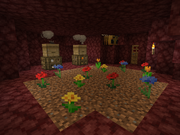
As long as bees have a beehive to live in and access to flowers, they are perfectly fine working in the dreary environment of The Nether.
To help improve the efficiency of the bees' work, place flowers near the hive so they can gather pollen and return to their hive as quickly as possible. You can also improve the efficiency of your bees by relocating them to the Nether or the End, as neither dimension experiences weather or daylight cycles, meaning that bees can work at any time (please verify). If you're worried about bees wandering too far away from their hives, it may be wise to build an enclosure to both protect them and prevent them from straying too far away. This is especially important if you choose to keep the bees in The Nether or in The End, as these dimensions can be particularly dangerous.
It is worth noting that the pollen particles that fall from bees can cause crops to advance growth stages similar to using bone meal. Thus, it can be beneficial to build your beehives near your crops to allow the bees to help them grow faster, although doing so will not improve the bee's efficiency in making honey.
Harvesting
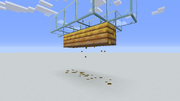
Dripping honey.
Pollinated bees fly into beehives and start working for a while. When done, they exit the hive, increasing the honey level by 1. When the honey level has reached 5, the block's appearance changes, indicating that it is full of honey, and produces dripping honey particles if suspended above the ground. If shears are used on a full beehive, it drops three honeycombs. Unlike with shearing pumpkins, these honeycomb items are generated directly in the center of the block, causing them to spray everywhere;[1] however this inconsistency is intended.[2] If an empty glass bottle is used on a full beehive, the bottle fills with honey, becoming a honey bottle. Harvesting honey or honeycomb causes any bees inside the hive to become aggravated toward the player. If there is a lit campfire; or fire directly underneath the hive (campfire within five blocks underneath, without obstruction), harvesting the hive does not aggravate the bees inside. Using a dispenser with a glass bottle or shears via redstone to harvest the hive or nest also prevents the bees from attacking the player.

In Java Edition, bees can be protected from the campfire by placing a carpet over it.
In Java Edition, you can set the campfire below ground level and place a carpet on top of it if you don't want the bees to take damage from the campfire. The carpet does not block the smoke, so the player can harvest the honey without angering the bees.
Avoiding Bee Anger
When a player uses a bottle or a shear on a bee nest or a beehive, the bees in it get aggravated and try to attack the player. If they succeed in landing an attack, the player gets poisoned and the bees themselves die in roughly a minute.
To prevent the bees from getting angry, the player can light a campfire directly underneath the bee hive or nest before harvesting. Since this carries the risk of bees taking damage from the fire, the campfire should be put out after using.
Or just place a carpet over the campfire. Then, it can stay there indefinitely without hurting bees in the nest or hive, and you can use shears any time the nest or hive is full. For this approach, you will need to put the campfire at least two blocks directly below the nest/hive (so you can put carpet in the block above it).
You can also collect bee products using a dispenser, as described in the automatic collection chapter below. If all the wiring seems overwhelming, just put a button on the side of the dispenser.
Even if there are no bees in a nest or hive, harvesting them or breaking them can anger bees if they are nearby. One way of making sure a nest or hive is empty before breaking it is to block all six sides of the hive with solid blocks so bees can't enter. Then wait until night and with no bees around, and the hive can be broken (or harvested) safely. The blocks must be solid, and touching the hive. Fence posts, glass panes and trap doors will not block the surface and contain the bees.
Products
Honey Bottles
Honey bottles can be farmed using glass bottles on beehives or bee nests. Bees will fly around a flower to collect pollen. If they carry the pollen back to their hive, then the honey level of the hive will be raised by 1. When the honey level reaches 5, the texture of the hive or nest will change to show honey dripping out, and you will be able to collect the honey. Then you can press the 'use item' button on the nest with a glass bottle in your hand to get a honey bottle. Honey bottles provide a stackable remedy for poison; unlike milk, they will not remove other buffs or debuffs.
Honey bottles can be crafted into honey blocks in your inventory's crafting grid; you do get the empty bottles back. Honey blocks have a variety of useful features: As a floor, they reduce fall damage by 80%, but also slow movement and jumping. As a wall, they let players slow their fall and avoid fall damage. When moved by pistons, they can drag along adjacent blocks and even creatures walking atop them. See their article for full details.
Honeycombs
Using shears on a hive or nest that is full of honey will extract three honeycombs. Four honeycomb can be crafted into a honeycomb block, which is a purely decorative block. Honeycombs are also used for crafting beehives. Here's the recipe for a beehive:
| Ingredients | Crafting recipe |
|---|---|
| Any Planks + Honeycomb |
Automatic Harvesting
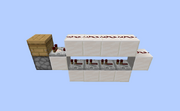
An example of a 1-block wide setup that will activate a dispenser once a beehive is ready for honey collection.
Dispensers can be used to harvest honey bottles and honeycomb from a hive using a redstone signal. The output of the dispenser must be pointing towards the beehive, and the dispenser must contain glass bottles to collect honey bottles, or shears to collect honeycomb. Collecting honey bottles will place the item directly into the dispenser, whereas collecting honeycomb will cause the items to drop onto the floor. Dispensers will deplete the durability of the shears with every use. Note that harvesting from the hives using dispensers will not anger the bees, so placing campfires underneath them is not necessary if you are choosing to harvest this way.
Redstone comparators are able to output a redstone signal from a beehive based on the honey level of the hive. Every time a bee exits the hive after having worked with the pollen it has collected, the honey level will increase by 1. Each honey level increases the redstone output from a redstone comparator by 1, to a maximum of 5, which is when the hive will change the appearance and indicate it is ready for harvest. By using this mechanic, one can set up a system with the output signal to activate a dispenser once the hive is full of honey to immediately gather the product of your choice.
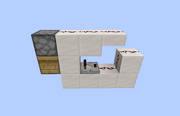
Another example of a 1-block wide setup that will activate a dispenser above a beehive when it is ready for harvest.
Observers are also able to detect changes in the state of a beehive when its honey level changes, and they can be very effective at activating a dispenser as soon as it's ready to be harvested. However, the observer will also output a signal every time the honey level of the hive changes, not just when the hive is ready to be harvested. This is problematic if trying to collect honey bottles, as the dispenser will eject a glass bottle whenever the observer activates it if the beehive is not ready to be harvested. It can lead to a lot of glass bottles being lost if there isn't a system to pick them back up again. Observers are better suited for harvesting honeycomb, as dispensers will not eject shears if the honey is not ready for harvest.
NOTE: A hive has 6 states: Empty, 1, 2, 3, 4, Full. A hopper holding 6 honey bottles (or 6 of any item that only stacks to 16) will give a comparator output of 2, whereas with 5 pearls the comparator only outputs 1. Using this knowledge, you can be clever and create a counter using hoppers and observers.
Automatic Collection
Honey Bottles
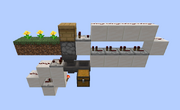
An example of a 1-block wide setup that will both collect honey bottles using a dispenser and filter out the honey bottles from the dispenser using an item sorter to place them into a chest, whilst allowing bees to collect pollen and work.
When a dispenser collects honey from a beehive or bee nest with a glass bottle in its inventory, a honey bottle will be placed into its inventory. In order to extract the honey bottles from a dispenser in a lossless fashion, the best way to do so is to set up an item sorter underneath the dispenser to collect only honey bottles. 8 of the 9 slots of the dispenser should be filled with as many glass bottles as possible, leaving at least one space empty for the honey bottles to go after the dispenser activates. The more glass bottles that are loaded into the dispenser, the longer this system is able to operate automatically before the dispenser requires restocking with more glass bottles.
Honeycombs
When a dispenser collects honey from a beehive or bee nest with shears in its inventory, 3 honeycombs will be ejected from the hive in a random direction and the shears inside the dispenser will lose 1 point of durability. Because of this, the goal is to restrict where the honeycombs can go and have a hopper or minecart with hopper to pick them up. Surrounding the hive in full blocks and leaving one block empty will help restrict where the honeycombs will be ejected. However, make sure that the front of the hive is not obstructed by any blocks, as it needs to be accessible to allow bees to enter and exit the hive.
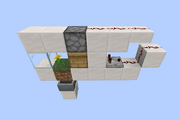
An example of a 1-block wide setup that will collect honeycombs using a dispenser and eject them into the same space the bees occupy to be collected by a minecart with hopper from below.
The dispenser should be filled with as many shears as possible to maximize the amount of time the system can operate. You may also wish to set up a way to automatically restock the dispenser with shears when the durability runs out.
Videos
| Design 1 (view on YouTube) |
|---|
| Design 2 (view on YouTube) |
|---|
| Design 3 (view on YouTube) |
|---|
| Design 4 (view on YouTube) |
|---|
| Design 5 (view on YouTube) |
|---|
